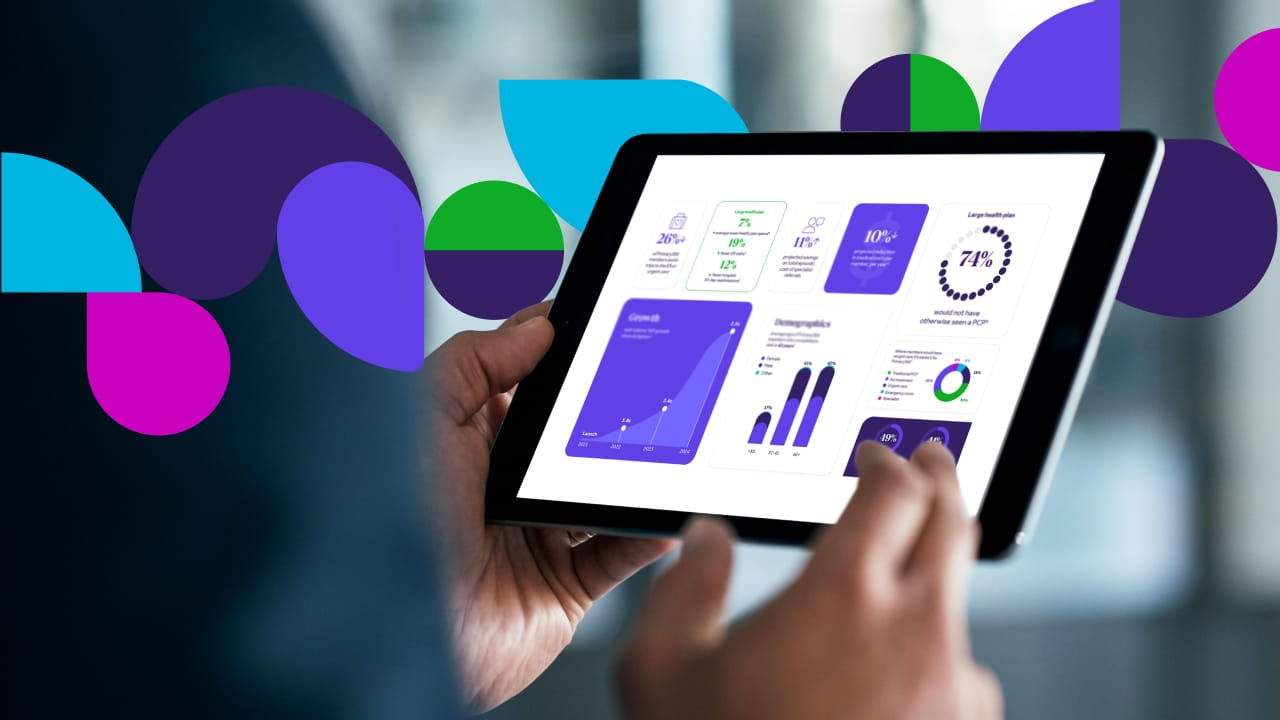WHITE PAPER
Key takeaways
Teladoc Health examined how AI is shaping the future of virtual care, offering insights from current use cases, provider perspectives and clinical outcomes. The findings highlight three essential themes:
- AI is already in use: Many health systems are leveraging AI today with real-world applications that support care teams and streamline operations.
- AI may enhance care and engagement: AI can improve patient outcomes, increase engagement and support more proactive, personalized care delivery.
- Responsible implementation is key: Building trust, ensuring transparency and choosing the right partners are critical to adopting AI effectively.
Jump to section
AI is moving to the forefront of healthcare delivery
AI in virtual care today: attitudes, opportunities and concerns
Physicians spot opportunities for AI adoption
Examples of clinical applications leveraging AI
Reducing risk: a few key questions to ask about AI solutions and potential partners
AI is moving to the forefront of healthcare delivery
AI in healthcare is no longer a concept, it’s a care enabler delivering real results, today
This white paper provides an overview of the intersection of virtual care and AI, including established, emerging and future use cases, coupled with practical guidance for evaluating virtual care AI offerings.
Early AI use typically operated behind the scenes and revolved around optimizing scheduling, proactive IT system maintenance and simple decision-tree assistance. Today, AI is operating in a much more visible fashion, helping organizations and care teams optimize clinical resources, speed clinical documentation, enhance patient and care team safety, improve clinical outcomes and generally offer a better patient and clinician experience. Many hospitals and health systems may not realize they have been using AI for a while because it has been embedded within some tools for years. Yet hype and confusion around the meaning and supposed “newness” of artificial intelligence remain high, making it hard for hospitals and health systems to visualize AI use cases and value.
ar·ti·fi·cial in·tel·li·gence
/noun/
a category of algorithm-based programs that are created for problem-solving
Note: The American Medical Association (AMA) uses augmented intelligence and AI to connote what is commonly referred to as artificial intelligence and AI.
AI defined
From the 1950s until about 15 years ago, the term artificial intelligence (AI) referred to machines that were created to mimic human behavior.
Today, and for the purposes of this paper, artificial intelligence refers to a category of algorithm-based programs that are created for problem-solving. It is a broad category, and examples include prediction models, credit risk calculators, patient-provider matching tools, recommendation engines and much more. Traditional AI systems could only produce previously defined outcomes, e.g., recommending a provider from a predefined list.
Generative AI is a newer category of AI that can create outputs that were not explicitly programmed or predefined. Examples include image generators, copywriting tools and more.
AI in virtual care today: attitudes, opportunities and concerns
By the end of 2024, the percentage of healthcare providers that had developed organization-wide AI strategies had tripled from the preceding year,1 and approximately 75% of healthcare organizations were experimenting with generative AI or scaling existing programs.2 Results have been encouraging, with 58% of organizations that are using AI getting or expecting positive ROI.3
Favorable attitudes toward AI on the rise
64%
of U.S. patients are supportive of healthcare providers using AI4
65%
of physicians say they see an advantage to using AI4
64%
of nurses reported they would like to have more AI tools5
The increasing AI activity is coming at a time when many digital healthcare tools and practices are gaining more acceptance among patients and practitioners. The increased use of virtual care, remote patient monitoring and consumer-oriented health apps and wearable devices has set the foundation for more extensive and visible AI use. In 2024, 64% of U.S. patients were supportive of their healthcare providers using AI as part of care delivery. That tracks closely with recent surveys about clinicians’ attitudes, as 65% of physicians said they can see an advantage to using artificial intelligence4 and 64% of nurses reported they’d like to have more AI tools.5
You can pull together nursing and tech and artificial intelligence to transform the way that we care for people and get upstream of disease processes and crisis and acute episodes.
Colleen Mallozzi, MBA, RN, Senior Vice President, Chief Nursing Informatics Officer, Jefferson Health
Clinicians’ and administrators’ optimism about AI is tempered by their concerns about potential risks to patient privacy and data, and about their organization’s ability to develop and manage artificial intelligence programs effectively. There are also worries about AI’s impact on patient-provider relationships and potential job losses. These concerns are all valid and are consistent with concerns about any new or expanded use of technology, including those raised about electronic health record systems and telehealth when those offerings were each in their emerging technology stage.
Product maturity can be a significant obstacle to safely and successfully applying AI tools and realizing their full value. There are now hundreds of healthcare technology vendors with various clinical AI offerings. Many of these companies, and the tools they sell, have only been around for a few years. They have not necessarily proven the efficacy of their tools or their ability to sustain and scale operations and do not yet have proven experience for client support. Internal operational maturity is also a potential challenge within hospitals and health systems. Many organizations lack high-level experience, knowledge and governance structures for setting policy, using AI responsibly, managing AI models and assessing the security and ethics of AI offerings from the vast array of relatively new healthcare IT vendors. These issues all need to be considered when evaluating clinically related AI tools and planning for potential adoption.

Use cases
Many hospitals and health systems are actively evaluating adoption of clinically related AI tools because of the great potential that the technologies can improve care quality, efficiency and patient and care team experiences. AI technology has proven effective in administrative use cases such as patient-provider resource management, staffing and scheduling recommendations. Clinical AI tools have also proven valuable in providing diagnostic decision support in radiology for a variety of clinical service lines and have more recently proven very powerful as a near real-time assistant for creating clinical documentation. These early foundations, plus more recent advances in AI capabilities such as generative AI, and broader availability and marketing presence are making more clinicians open to, if not enthusiastic about, having much more visible AI support.
4 out of 5
nurses think AI would be very helpful for eliminating tasks that contribute to job dissatisfaction6
Roles that provide direct patient care are especially optimistic about AI’s ability to reduce the data entry and other administrative burdens of their jobs. Nearly 4 out of 5 nurses (79%) think AI would be very helpful for eliminating tasks that contribute to job dissatisfaction,6 while physicians reported their highest AI enthusiasm levels for tools that could reduce administrative burdens, such as completing documentation (cited by 54% of physicians surveyed) and prior authorization (48%). Sixty-nine percent of physicians said the most promise for AI is its potential to improve workflow.7 For clinical documentation, an area where an overwhelming percentage of clinicians express job dissatisfaction, AI can automatically generate conversation transcripts, extract relevant data and create a properly structured note in the appropriate documentation platform (electronic medical records, etc.) with all needed clinical, diagnosis and billing data. Clinicians then only need to review, edit if necessary and sign the final output (e.g., data entry, order). This all happens within a few minutes at most, saving clinicians valuable time that would otherwise have been spent producing the documentation themselves.
Physicians spot opportunities for AI adoption
54%
cited completing documentation4
48%
cited prior authorization management4
69%
said there is potential to improve workflow7
As noted, AI is integrated within some virtual care solutions that have been in place for years.8 AI has been embedded within virtual care platforms for functionality, such as predicting which patients will enroll in wellness, chronic condition management or other programs, selecting and delivering patient-specific educational content, supporting staff and infrastructure planning, matching patient consult requests with the appropriate clinician, conducting continuous performance monitoring and issuing predictive maintenance notifications for telehealth equipment.
Clinical applications for AI are continually evolving, including several that can leverage or augment existing virtual care tools and programs. These programs may leverage data inputs including ambient listening, video streams (aka “computer vision”), device signals and/or links to electronic health records (EHR) and other data sources, either independently or in combination, to facilitate substantial changes and improvements in care models. Some examples are shown in the table below.
Examples of clinical applications leveraging AI
These capabilities, in addition to AI-powered clinical support, raise the levels of care and responsiveness that can be provided, whether in a hospital or at an alternative site of care.
AI-enabled ambient listening functionality is a great example of how the technology can improve care delivery and quality. In this use case, the AI application “listens” to discussions and other activities at the point of care. The ability to capture conversations and other relevant sounds (e.g., alarms) and then make next-best-action recommendations to care teams is a key part of a “smart” healthcare environment, whether in a clinical or other facility, potentially including patient homes.
Pilot programs around ambient clinical documentation have been particularly successful in reducing clinician administrative burden and improving the patient experience.
Bain & Company Healthcare IT Spending: Innovation, Integration, and AI
More advanced ambient listening solutions can provide advanced monitoring that can raise care quality. For example, AI solutions can detect an alarm, identify its source and direct a camera to locate the issue and provide a real-time stream to the virtual nursing station responsible for monitoring the patient. The camera might show that a patient is convulsing (determined by motion analysis algorithms) or that an IV bag is running low, or it could zoom in on a monitor screen. Combining this type of AI-powered audio and video analysis with signals from other devices is changing what’s possible in virtual monitoring programs, which is a reason why virtual sitter adoption growth has been strong in recent years. The advanced AI monitoring and patient protection features embedded within the Teladoc Health virtual sitter solution enable remote staff members to monitor up to 25% more patients than with solutions that do not include AI, 9 helping to increase the capacity of healthcare inpatient teams.

Reducing risk: a few key questions to ask about AI solutions and potential partners
Despite the numerous examples of real virtual care and AI use cases that are producing value, and the continued emergence of new capabilities, a gap persists between the heightened level of interest in advanced generative AI tools expressed by organizations and actual implementations. Uncertainty about AI-related risk and how to manage those risks is a major reason. More than half (52%) of leaders at provider organizations cited risk concerns as their biggest challenge in implementing generative AI.10
The risks vary by use case, the underlying AI model and how it is managed, the systems, processes and experience the organization has for managing AI and more. The technology vendor a hospital or health system chooses to work with is a major variable in its risk exposure, as well as the time to realize value for its investment.
As gen AI deployment progresses, many surveyed leaders share that their organizations are focused on initially using this technology to support clinically adjacent applications, with clinical and administrative efficiency and patient/member engagement surfacing as areas believed to gain the most from gen AI. However, as organizations develop strong competencies in governance and risk management, we expect additional focus on core clinical applications as well, further improving the overall patient/member experience.
McKinsey & Company, Generative AI in healthcare: Adoption trends and what’s next
Questions to ask technology partners
How do the AI tools integrate with existing EHR and virtual care systems?
A key consideration here is if the AI solution/functionality needs to be purchased, maintained and accessed separately or if it is seamlessly integrated into existing tools and workflows used by your care teams. For add-on solutions, be sure to investigate the effort that will be required for integration and to what extent it is possible.
How are workflows affected?
Will using AI functionality require clinicians to open a new application or will it be embedded within the virtual care environment? Will it add work and effort to their routines, or will it add value without extra burden? The level of integration influences training requirements and user acceptance.
How is the AI model developed and managed?
To minimize risks, it is important to ensure the AI tools you adopt are developed and managed within a responsible AI framework. Responsible AI frameworks help ensure that principles and requirements for health equity, clinical efficacy, reliability, security, transparency and explainability, among others, are ingrained in the design and functionality of the tools. Ask about your potential partners’ responsible AI framework and governance. Additionally, ask how often the AI model is reviewed against the evolving responsible AI framework, how frequently it is updated to ensure continued adherence and how updates are shared with tools that are already in production with clients.
How is patient data protected?
Data collected and used by AI tools in healthcare settings is protected by HIPAA. Ask for details about the provider’s approach to data security and the certifications it has achieved. Ask what type of data is collected, where it is processed (on the “edge,” on local servers, in the cloud), if it is stored and for how long, how it is transferred and who actually owns the data and is responsible for protecting it at all steps. Be sure to assess the technology provider’s architecture, security protocols, certifications and incident response plans as part of your risk evaluation.
Do the AI training models have guardrails against perpetuating health inequities?
Artificial intelligence has the potential to perpetuate biases and inequities. To prevent this, use AI solutions that were trained on data models with proper representation, and ask about how AI recommendations and other outputs are developed. This should be part of the vendor’s responsible AI framework. Asking these questions may also provide insight into how transparent and explainable the AI solution is.
How long has the vendor been offering this particular tool? Are they proven?
While brand-new tools and tools from relatively new companies may sound fantastic, using such new tools should come with caution. Many newer AI tools, especially those with GenAI components, are being targeted to assist care teams with clinical decision-making. When newer tools are employed, care should be taken to build in heavy oversight from experienced clinicians until the tools establish a track record of clinical and operational efficacy and safety. If you are unsure of the clinical track record of tools you are considering, ask for customer references.
Conclusion
Organizations that represent potential AI users need to know that solutions are reliable, ethical and secure and won’t impose extra work, frustration or other burdens on their staff. Potential AI use cases must address a clear need or provide a path to measurable value (i.e., operational efficiency, business and/or clinical outcome improvements). Their fit and value must be easy to understand, even if the underlying AI technology isn’t. Potential solutions that don’t meet these criteria should be viewed skeptically. Fortunately, AI is already contributing to many successful and innovative virtual care programs running today that hospitals and health systems can learn from to inform their future plans and policies.
20+ years
of leading virtual care innovations9
AI is gaining new and expanded interest and support within virtual care but is not new to Teladoc Health. We have been developing our own artificial intelligence capabilities and integrating the functionality into a suite of virtual care solutions for more than 10 years. We currently have more than 60 models in production, plus more in development. All of our AI development is done within a responsible AI, privacy-by-design framework by our large in-house data science team working with industry-leading technology partners, such as Microsoft, and our many clinical partners throughout healthcare. Our architecture designs focus on processing data at the edge to further protect patient data and privacy and sending only the minimum amount of anonymized data to the cloud to support triggered actions. This approach provides the additional benefits of improving performance by reducing latency (which is especially valuable for real-time monitoring), reducing network dependence and reducing operating costs.
People are involved at every stage of AI development at Teladoc Health; we do not allow AI developments and outputs to be released without thorough vetting by humans. All solutions are thoroughly tested and evaluated for bias and safety before they are released into production.
Our experience and approach have resulted in mature, proven AI functionalities that can be incorporated into personalized patient care models. One example is a model that makes patient-specific recommendations for chronic condition management. Diabetic patients in our AI-assisted diabetes management program reduced their A1c by 2.1% in three months, and then sustained their new level for more than five years.11 AI is used throughout our tools in various capacities to enhance patient-specific care for a wide variety of conditions by monitoring vital signs and other variables, detecting changes in health acuity, recommending next-best actions, providing timely, relevant patient education content or self-care reminders and more. Besides the more than 60 examples of AI being used within Teladoc Health solutions, we have many more in development in other areas, including enhanced clinical documentation and new smart room capabilities.
Ready to ask questions or get a product demo?
Take a deeper dive with these resources
1Bain & Company, “Healthcare IT Spending: Innovation, Integration, and AI.” September 2024. www.bain.com/insights/healthcare-it-spending-innovation-integration-ai/.
2Deloitte 2024 Life Sciences and Health Care Generative AI Outlook Survey. https://www2.deloitte.com/us/en/pages/consulting/articles/generative-ai-in-healthcare.html.
3Deloitte 2024 Life Sciences and Health Care Generative AI Outlook Survey. https://www2.deloitte.com/us/en/pages/consulting/articles/generative-ai-in-healthcare.html.
4McKinsey & Company, “Generative AI in healthcare: Adoption trends and what’s next.” July 25, 2024.
5American Nurses Association Foundation Nurses Survey, conducted with McKinsey & Company, March 2024; summary available at: https://www.mckinsey.com/industries/healthcare/our-insights/the-pulse-of-nurses-perspectives-on-ai-in-healthcare-delivery.
6American Nurses Association Foundation.
7AMA.
8Teladoc Health has more than 60 secure AI models in production across various offerings and its AI models have analyzed more than 2.6 billion data points.
9Teladoc Health data.
10McKinsey.
11DS-10609 For members starting A1c ≥ 8%.










